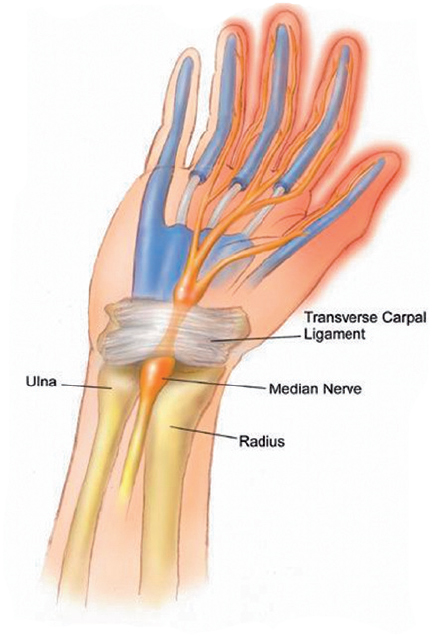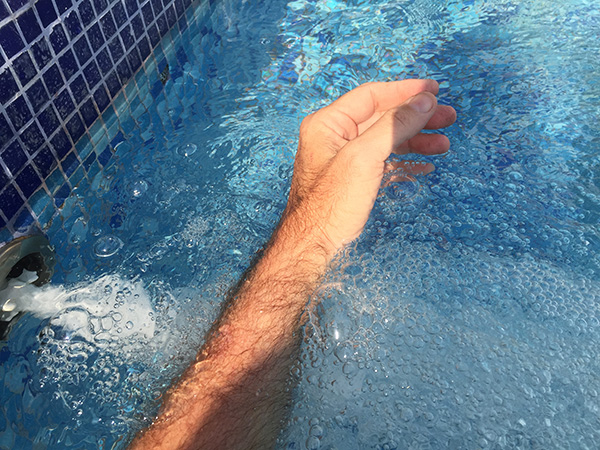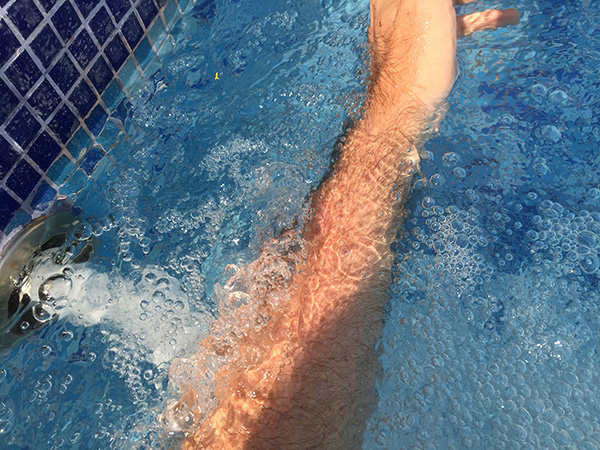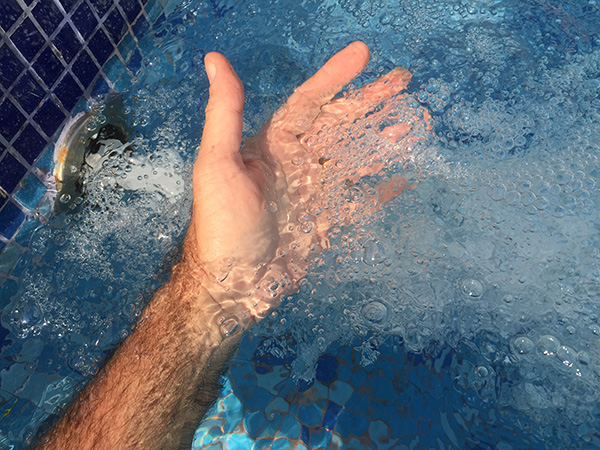Repetitive stress injury (RSI) & Focal Dystonia
The hands are said to have evolved from the flipper of a dinosaur fish. A simple enough beginning considering that we can literally do magic with them on our instrument.
A professional guitarists does not need to practice more than 2 hours a day. Among the great Segovia truths, this one stands out: "Those who say that they practice 8 hours a day are either lying or stupid... my practice hours are cubic hours" . If you are stupid, then make sure you read the following article. If you are not, do it anyway. Read more about daily practice here.
Guitar Players and musicians in general ought to be very aware of the fact that their playing apparatus is submitted to strains that if not approached in the correct manner (using the best technique and warming up generously) will most certainly lead to injuries of different kind. The devastation is that typically the only way to cure these injuries is by abstaining from playing altogether and depending on each case, this is always more or less devastating especially if you make a living with the guitar. The typical practice scenario should not be more than 2 hours every day. Those players that claim to practice 8 hours a day probably do so for a few weeks until they hurt themselves and then they stop practicing for months. That is not good. The best way to get about practice is being very consistent and persevere: practice 2 hours EVERY DAY and you will be a maser and you will never hurt yourself. The key words are not "2 hours" but EVERY DAY. If you divide your practice in 2 parts, so much better. One hour in the morning and one hour in the afternoon. I also recommend you divide these hours in several 10-15 minutes sessions with a 2-3 minutes resting space in between.
In the video above I show my "typical" warm up routine.
Actually, the best way to measure your practice is better done when you think in terms of a week, month or year. You should practice anywhere between 15 and 20 hours per week, 60-80 hours per month, 750-1,000 hours per year. What elevates the quality of your practice is spreading out these hours evenly. It is no good to practice 4 hors today and skip practice tomorrow.
You can practice for longer stretches of time sporadically and only if you take breaks regularly and take the time to massage your hands and arms regularly. Whenever you practice, you must stop playing the minute you feel any type of pain in your tendons, joints or muscles. A good warm up session is essential for the guitar player just as it is essential for the athlete that aims at breaking his own personal records. Allow your arms, hands and fingers to get into the playing gradually.
What is crucial is that you increase your practice schedule gradually. Always remember that the muscles tendons, articulations and ligaments that the player stresses regularly are very minute and the work that the player demands from his fingers is to say the least amazing. Never underestimate this stunning feat that your fingers undergo on a regular basis. It is actually miraculous that we do not injury ourselves more often given the fact that most of us do not even incorporate a few minutes to warm up before starting with their daily practice routine.
The correct guitar Technique is a must because it will allow you to achieve the desired results in the easiest, less straining way. Einstein used to say that humans are silly because "they expect to achieve new results without changing anything in the way they try to attain these new results". This translates into: If you are playing a musical phrase and you still cannot get it right and you have practiced it thoroughly for months, you must change the fingering, the technique or other elements related with the musical passage in question in order to attain the sought after result. Stubbornly repeating the same defective rituals will not bring the results you expect. Guaranteed ! It is crucial that you understand the following truth very well: Say John Williams or any other great player you admire plays a piece using a fingering that allows him to get the phrase just perfect and say that you try to imitate him but do not get the same result, make sure that you realize that your are not "wired" exactly like John Williams and that you will need to change or adapt the fingering to your very unique anatomy. The sooner you understand and apply this concept, the better.
RSI, Repetitive stress injury (RSI) is caused by repeated or excessive movement of the shoulders and arms. This is perhaps the most common injury professional players and dedicated aficionados are exposed to and you will not believe how many players suffer from this condition.
In order for the shoulder, arms, and hands to move, the muscles of the upper body must contract. Repetitive stress injury occurs when certain movements are made repeatedly, causing: · a diminished blood flow and oxygen supply to the muscles · tightening of the structures of the upper body, which makes them more susceptible to injury · rubbing of tendons against ligaments or bones, which causes inflammation of the tendons · pinched nerves, if tissues are inflamed or if repetitive movements rub the nerve. Poor posture when carrying out the same activities is the origin of the illness. Read the Carlevaro Technique pages on mangore.com to learn about the correct classical guitar technique and especially the correct playing position.
RSI conditions include: · carpal tunnel syndrome, which causes pain and other symptoms in the hand and wrist · tendonitis, which is an inflammation of the tendons in any part of the body · bursitis, which is an inflammation of the sac that cushions a joint · ganglions, which are cysts that may occur on a tendon.
Avoiding overexertion of the arms and shoulders can prevent many cases of RSI. Warming up and stretching the muscles before activity may decrease the risk. Using proper body mechanics may also lessen the risk of injury.
Taking regular breaks during repetitive activities, and doing strengthening exercises may help.
Learning proper methods of sitting, positioning the feet, lifting, and bending may also decrease the risk of RSI.
Minor pain or injury may require RICE therapy: · rest or reduced activity · ice or cold packs applied to the affected area · compression of the area, such as with ace bandages or wrist splints · elevation.
Non steroidal anti-inflammatory drugs (NSAIDs), such as ibuprofen and naproxen, may be used to reduce inflammation and discomfort. In some cases, a corticosteroid may be injected into the affected area.

In Focal hand Dystonia, we are presented with a much more devastating scenario because this is a condition that simply annuls the functioning of fingers and is if not impossible, very hard to cure or eradicate.. The fingers either curl into the palm or extend outward without control. In high-level musicians, the condition is referred to as Musician's Focal Dystonia, or simply musician's Dystonia. As you can probably imagine it is tremendously frustrating because it is a condition that affects mostly professionals who dedicate many years and hours a day perfecting the instrument. David Leisner, Liona Boyd are some of the players that I know have had to face this tremendous crossroad in their professional careers but I know for a fact that the list is far greater especially if you extend it to the less known players which actually counts for the majority of players. It is curable but there is not a standard method to achieve the recovery. Mostly it is personal research with lots of trial and error involved. It is still not known with certainty what causes the illness but everything points to an anatomically defective technique. and, of course, and as with all other illnesses, to a genetic predisposition. Being the technique of the classical guitar relatively new, it is very possible that in the years to come certain technical approaches will be discarded altogether. Carlevaro Technique is definitely a safe approach to classical guitar technique and I teach it on mangore.com.
Emergency TREATMENT
Following is what I recommend you do as soon as the first symptoms of either RSI or any form of Arthritic pain starts to manifest during or after playing.
1) Feel with your fingers pressing gently the area(s) in your arm or hands where you feel pain... Typically these areas are located in the forearm in the vicinity of the elbow. In other instances, the pain is centered in one or more fingers. The best treatment by far, is to massage with water Hydro Massage. A powerful 1 or 2 HP motor pushing water against the affected area will make miracles. You will immediately feel the relief and because of the way it is delivered, the water will take the relief deep inside your arm and distribute the cure very evenly... one or 2 sessions alone will make all the difference. You should so this daily after each practice session if you have a concert coming up and you want to avoid running the risk of having to cancel it altogether.

In Latin America which is mostly Tropical, most people have pools in their homes which makes what I describe above much easier to do and I realize that this may constitute an obstacle in other parts of the world. You will probably have to go to a SPA or Sauna where these types of massaging devices are used regularly. Still, I realize that this may be a mayor obstacle. I would not insist nevertheless if I did not know for a fact that nothing is quite as efficient as the Water Pressure treatment. In the image below, the water is directed to the elbow area. The arm must be rotated slowly as the water hits it so as for every side to be generously massaged. You should do this for 5 minutes for each arm and if at all possible repeat for an extra 5 minutes. You will begin to see improvements after the first session, Guaranteed.

Massage the hands as well, Rotate them in the water jet so as to alleviate and dissipate any type of tension that may have accumulated. The water pressure on the fingers will bring amazing relief and your hands will feel ready for a practice session in just a few minutes.

Long Term TREATMENT
As soon as you have solved your short term issues regarding pain so as to be able to play the gig you have signed up for, you must absolutely change things in your playing and practicing habits in order to get rid of this problem once and for all. You must change something or the problem will not go away. The main things you have to keep under close scrutiny are the following:
1) Are you applying too much pressure to the left hand thumb and/or do you apply too much pressure when stopping notes on the fingerboard? This is a very common mistake many players make and the tension is passed from one hand to the other and the quality of your playing is affected enormously. Typically, when we tense one hand we tend to reflect the same reaction in the other hand.
2) Do you tense any art of your body while you are playing? You must learn to do a "muscular check" during performance and ensure that not a single muscle is tense anywhere in your body. If you observe closely, you will be surprised to see how many points in your body tense up as you play. The good news is that you can correct this and play very relaxed limiting the tension only to those muscles directly involved in the playing
3) Warm up very thoroughly before playing. It is amazing how many players just get in the playing without any preparation and this is one of the worst things you can do. As the years add up, your body will need more and more warming up. Again, I recommend that you please read this article I wrote on Warm up sessions and practice in general.
There is also a very important psychological factor involved in all these conditions. You feel devastated and the loss of control can make you feel quite depressed and anxious. Therefore, the main objective is that you prove to yourself that you have control over the situation. In other words, you must find and apply a treatment that you know will give the control back to you. This in turn will diminish anxiety and the illness will recess. You must be constant with the treatment and apply the massaging I recommended earlier because doing nothing will add to nothing and simply stop playing will alleviate the pain which will return as soon as you go back to your old habits.
Most musicians I know had to deal with some type of condition at some point in their career. It is simply part of the whole. The type and quantity of pieces that we can play is enormous and the playing apparatus is exposed to strains that our predecessor simply did not know. In the 80's they even had idiotic slogans such as "No pain no Gain"... well, that is simply stupid. As soon as pain shows, STOP!
Changing a few typically small habits will make all the difference. See what aspects of technique cause the greatest stain and try to limit the number of pieces that use this particular technique in excess. Tremolo for instance can be quite straining. Some players (Ana Vidovic) have developed a 2 fingers tremolo to avoid problems altogether. The a finger is typically the one finger that requires the more work on the forearm and will drain you of your energies the fastest. I invite you to observe your playing apparatus closely because all these conditions would be non existent if we knew our playing apparatus better...
The continuation of this class is in the members area, become a member today.
 Back to Top
Back to Top
